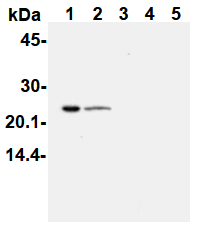| Specificity |
This antibody reacts with human ASC of U937, and HL-60, but not with Jurkat, HeLa, NB4, or HPB-ALL.
It does not react with mouse NIH/3T3, L5178Y, or WR19L.
It does not react with rat PC12. |
| Background |
ASC (apoptosis-associated speck-like protein containing a CARD (caspase recruitment domain)) is a 22 kDa soluble protein, located in the cytosol of HL-60 cells. In apoptotic HL-60 cells, it is able to visualized as a speck, forming an insoluble aggregate. The C-terminal domain of this protein contains a CARD, suggesting that ASC may have proapoptotic activity in HL-60 cells. Recent data have indicated that ASC plays a role of adaptor protein linking various PAAD (Pyrin, AIM, ASC, and death domain-like) family proteins to pathways involved in NF-κB and procaspase-1 activation. |
| Note |
This product was originally produced by MBL International.
Protocol: SDS-PAGE & Western Blotting
1) Wash the cells 3 times with PBS and suspend with 10 volume of cold Lysis buffer (50 mM Hepes, pH 7.4, 250 mM NaCl, 0.1% NP-40, 2 mM EDTA, 10% glycerol) containing appropriate protease inhibitors. Incubate it at 4oC with rotating for 30 minutes, then sonicate briefly (up to 10 seconds).
2) Centrifuge the tube at 12,000 x g for 10 minutes at 4oC and transfer the supernatant to another tube. Measure the protein concentration of the supernatant and add the cold Lysis buffer to make 6 mg/mL solution.
3) Mix the sample with equal volume of Laemmli’s sample buffer.
4) Boil the samples for 3 minutes and centrifuge. Load 10 µL of the sample per lane in a 1 mm thick SDS-polyacrylamide gel for electrophoresis.
5) Blot the protein to a polyvinylidene difluoride (PVDF) membrane at 1 mA/cm2 for 1 hour in a semi-dry transfer system (Transfer Buffer: 25 mM Tris, 190 mM glycine, 20% MeOH). See the manufacture's manual for precise transfer procedure.
6) To reduce nonspecific binding, soak the membrane in 10% skimmed milk (in PBS, pH 7.2) for 1 hour at room temperature, or overnight at 4oC.
7) Incubate the membrane with primary antibody diluted with PBS, pH 7.2 containing 1% skimmed milk as suggest in the APPLICATIONS for 1 hour at room temperature. (The concentration of antibody will depend on condition.)
8) Wash the membrane with PBS-T [0.05% Tween-20 in PBS] (5 minutes x 3 times).
9) Incubate the membrane with the 1:10,000 HRP-conjugated anti-mouse IgG diluted with 1% skimmed milk (in PBS, pH 7.2) for 1 hour at room temperature.
10) Wash the membrane with PBS-T (10 minutes x 3 times).
11) Wipe excess buffer on the membrane, then incubate it with appropriate chemiluminescence reagent for 1 minute.
12) Remove extra reagent from the membrane by dabbing with paper towel, and seal it in plastic wrap.
13) Expose to an X-ray film in a dark room for 3 minutes.
14) Develop the film as usual. The condition for exposure and development may vary.
(Positive controls for Western blotting; U937, HL-60) Immunoprecipitation
1) Wash the cells 3 times with PBS and suspend with 10 volume of cold Lysis buffer (50 mM Hepes, pH 7.4, 250 mM NaCl, 0.1% NP-40, 2 mM EDTA, 10% glycerol) containing appropriate protease inhibitors. Incubate it at 4oC with rotating for 30 minutes, then sonicate briefly (up to 10 seconds).
2) Centrifuge the tube at 12,000 x g for 10 minutes at 4oC and transfer the supernatant to another tube.
3) Add primary antibody as suggest in the APPLICATIONS into 300 µL of the supernatant. Mix well and incubate with gentle agitation for 30-120 minutes at 4oC. Add 30 µL of 50% protein G agarose beads resuspended in the cold Lysis buffer. Mix well and incubate with gentle agitation for 1-4 hour(s) at 4oC.
4) Wash the beads 3-5 times with 1mL of 1% Triton X-100/PBS (centrifuge the tube at 2,500 x g for 10 seconds).
5) Resuspend the beads in 20 µL of Laemmli’s sample buffer, boil for 3-5 minutes, and centrifuge for 5 minutes. Use 10 µL/lane for the SDS-PAGE analysis. (See SDS-PAGE & Western blotting.)
(Positive controls for Immunoprecipitation; HL-60) |






























































































































































































































































 Germany
Germany
 Japan
Japan
 United Kingdom
United Kingdom
 China
China




